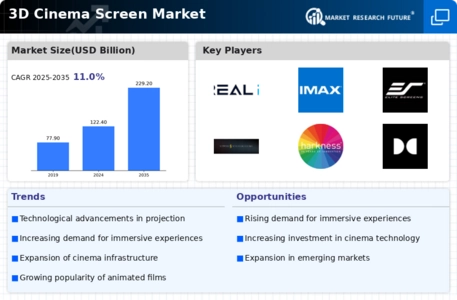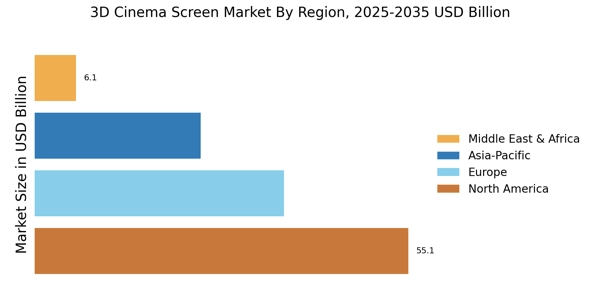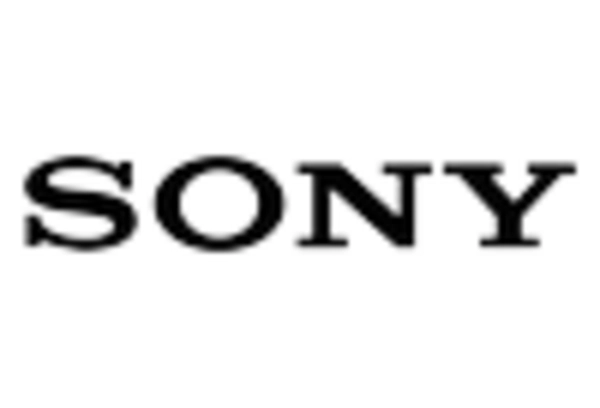Expansion of Content Libraries
The 3D Cinema Screen Market is benefiting from the expansion of content libraries, particularly with the rise of animated and blockbuster films designed specifically for 3D viewing. Major studios are increasingly producing films that leverage 3D technology, which not only enhances visual appeal but also drives higher box office revenues. Recent statistics indicate that films released in 3D have consistently outperformed their 2D counterparts, with an average revenue increase of 40%. This trend encourages cinema operators to invest in 3D screens to capitalize on the growing number of 3D releases. Furthermore, the availability of diverse content, including documentaries and independent films in 3D, broadens the audience base, making the 3D Cinema Screen Market more attractive to a wider range of viewers.
Growing Popularity of Home 3D Systems
The 3D Cinema Screen Market is also influenced by the growing popularity of home 3D systems, which are becoming more accessible to consumers. As technology advances, home entertainment systems are now capable of delivering high-quality 3D experiences, prompting consumers to seek out similar experiences in commercial cinemas. This trend suggests that cinema operators must differentiate their offerings to maintain audience interest. Market analysis indicates that the home 3D system market has grown by approximately 15% in the past year, indicating a shift in consumer expectations. To compete, cinemas are enhancing their 3D offerings, ensuring that they provide a superior experience that cannot be replicated at home. This dynamic interplay between home and cinema experiences is likely to shape the future of the 3D Cinema Screen Market.
Rising Demand for Immersive Experiences
The 3D Cinema Screen Market is witnessing a rising demand for immersive experiences among consumers. As audiences seek more engaging and interactive forms of entertainment, 3D cinema offers a unique solution that enhances storytelling through depth and realism. This trend is particularly evident in the younger demographic, which shows a preference for experiences that go beyond traditional 2D films. Market data suggests that ticket sales for 3D films have increased by 25% in the last year, reflecting this growing consumer interest. Cinemas are responding by upgrading their screens and sound systems to meet these expectations, thereby driving growth in the 3D Cinema Screen Market. The emphasis on creating memorable experiences is likely to continue, pushing cinema operators to innovate and invest in advanced 3D technologies.
Increased Investment in Cinema Infrastructure
The 3D Cinema Screen Market is experiencing increased investment in cinema infrastructure, driven by the need to enhance the overall viewing experience. Cinema chains are recognizing the importance of modernizing their facilities to attract audiences, leading to significant upgrades in seating, sound systems, and, notably, 3D screens. Recent reports indicate that cinema operators are allocating up to 20% of their annual budgets towards technological upgrades, including the installation of state-of-the-art 3D screens. This investment not only improves the quality of the viewing experience but also positions cinemas as competitive entertainment venues. As more cinemas adopt advanced 3D technologies, the market is likely to see a corresponding increase in attendance, further fueling growth in the 3D Cinema Screen Market.
Technological Innovations in Projection Systems
The 3D Cinema Screen Market is experiencing a surge in technological innovations, particularly in projection systems. Advancements in laser projection technology have enhanced image quality, providing brighter and more vivid colors. This improvement is crucial as it directly influences audience engagement and satisfaction. The integration of high dynamic range (HDR) technology further elevates the viewing experience, making it more immersive. As a result, cinema operators are increasingly investing in these advanced projection systems to attract audiences. According to recent data, the adoption of laser projectors in cinemas has increased by approximately 30% over the past year, indicating a strong trend towards modernization in the 3D Cinema Screen Market. This shift not only enhances the visual experience but also reduces operational costs, making it a compelling choice for cinema owners.

















Leave a Comment